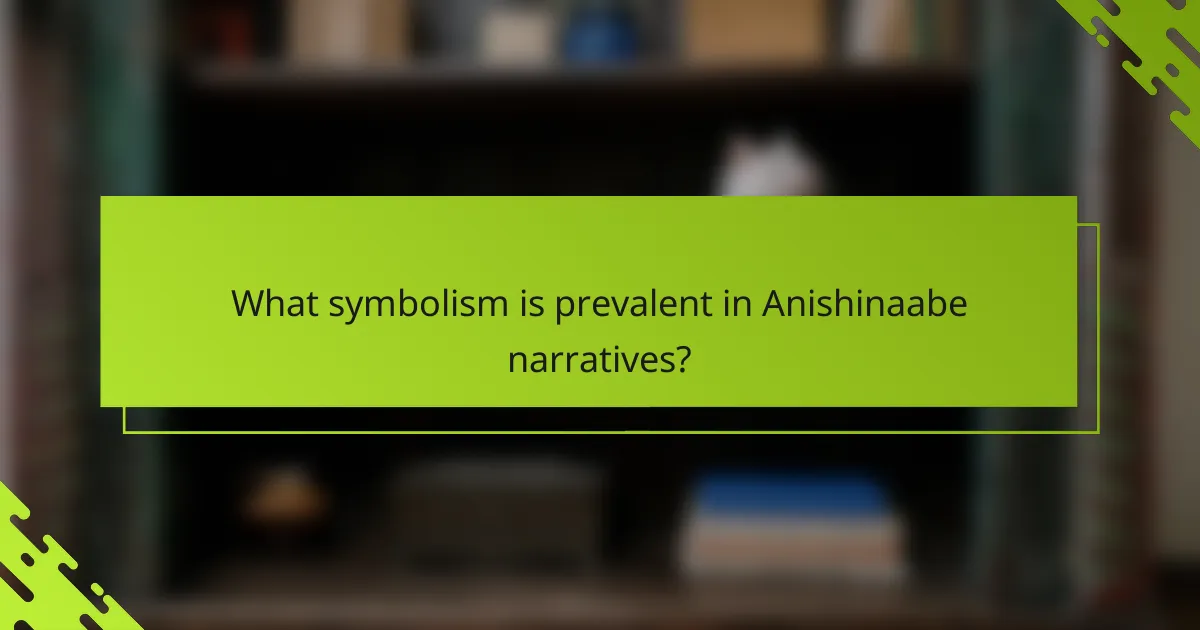Anishinaabe storytelling plays a crucial role in preserving cultural identity and fostering community engagement. Key themes include connection to nature, morality, and resilience. Symbolism within these narratives reflects cultural values and teaches important lessons. The storytelling process emphasizes community involvement and addresses contemporary issues like social justice and environmental stewardship.

What are the key themes in Anishinaabe storytelling?
Key themes in Anishinaabe storytelling include connection to nature, cultural identity, morality, and community values. These stories often convey lessons through symbolism and reflect the community’s history and beliefs. Anishinaabe narratives emphasize the importance of relationships, both among people and with the environment. They serve as a means of preserving traditions and fostering communal ties. The use of animals and natural elements as characters highlights the interconnectedness of all living things.
How do cultural values influence storytelling themes?
Cultural values significantly shape storytelling themes in Anishinaabe traditions. They emphasize community, nature, and spirituality, reinforcing collective identity and moral lessons. Stories often reflect values such as respect for the land, interconnectedness, and the importance of family bonds. These themes resonate deeply, fostering engagement and preserving cultural heritage. Anishinaabe storytelling serves as a medium for transmitting these core values across generations, ensuring their relevance in contemporary contexts.
What role do nature and the environment play in narratives?
Nature and the environment play a crucial role in Anishinaabe storytelling by shaping themes, symbolism, and community engagement. The natural world serves as a backdrop for narratives, influencing cultural identity and values.
Anishinaabe stories often feature elements like animals, plants, and landscapes, reflecting the interconnectedness of life. These elements symbolize deeper meanings, such as resilience, harmony, and respect for the earth. For example, the story of the water spirit emphasizes the importance of clean water and environmental stewardship.
Community engagement is fostered through storytelling, as these narratives are shared in gatherings, reinforcing social bonds. The act of storytelling itself becomes a communal experience, where participants connect with their heritage and each other.
Overall, the environment is not just a setting but an active participant in the stories, embodying teachings that guide Anishinaabe life and culture.
How are family and community dynamics portrayed in stories?
Anishinaabe storytelling portrays family and community dynamics as interconnected and essential for cultural continuity. Stories often emphasize collective values, relationships, and responsibilities. Symbolism in narratives reflects community roles, illustrating how individuals contribute to the greater whole. Themes of kinship and shared experiences foster a sense of belonging and identity. Through oral traditions, community engagement is reinforced, ensuring the transmission of knowledge and values across generations.

What symbolism is prevalent in Anishinaabe narratives?
Anishinaabe narratives often symbolize interconnectedness, nature, and spirituality. Common symbols include animals, plants, and celestial bodies, reflecting cultural values and teachings. For instance, the bear represents strength and courage, while the water symbolizes life and purity. These symbols foster community engagement and convey moral lessons, reinforcing the importance of harmony with the environment.
Which animals are commonly represented and what do they symbolize?
Commonly represented animals in Anishinaabe storytelling include the bear, wolf, eagle, and turtle. These animals symbolize strength, loyalty, vision, and wisdom, respectively. The bear represents healing and courage, while the wolf embodies community and cooperation. The eagle signifies spiritual insight, and the turtle symbolizes longevity and stability. Each animal’s unique attributes enhance the narrative and cultural teachings within the community.
How do colors and natural elements convey deeper meanings?
Colors and natural elements in Anishinaabe storytelling convey deeper meanings by symbolizing emotions, values, and community connections. Each color represents specific traits; for example, red symbolizes strength and love, while blue signifies peace and tranquility. Natural elements like water and earth reflect the interconnectedness of life and the importance of harmony within the community. This symbolism enhances storytelling, reinforcing cultural identity and shared experiences. Through these elements, storytellers engage listeners, fostering a sense of belonging and understanding of Anishinaabe traditions.
What is the significance of dreams and visions in storytelling?
Dreams and visions hold deep significance in Anishinaabe storytelling, serving as conduits for wisdom and cultural identity. They often symbolize personal and communal experiences, guiding characters and audiences through moral lessons. Dreams can reveal hidden truths, connect individuals to ancestors, and offer insight into the natural world. This interplay enriches narratives, fostering community engagement and preserving traditions. By integrating these elements, Anishinaabe storytelling emphasizes the importance of interconnectedness and collective memory.

How does storytelling serve as a tool for community engagement?
Anishinaabe storytelling fosters community engagement by preserving cultural identity and shared values. It creates a platform for collective memory and strengthens social bonds. Themes such as nature, spirituality, and resilience are central, reflecting community experiences. Symbolism in stories serves as a tool for imparting wisdom and moral lessons, encouraging active participation in cultural traditions. As a result, storytelling becomes a vital mechanism for fostering unity and belonging within the Anishinaabe community.
What are the methods of sharing stories within the community?
Anishinaabe stories are shared through oral traditions, community gatherings, and artistic expressions. These methods foster connection and preserve cultural heritage. Storytelling often occurs during seasonal events, ceremonies, and family gatherings, reinforcing community bonds. Additionally, modern mediums like social media are increasingly used to reach broader audiences while maintaining traditional themes and values.
How do storytelling events foster cultural preservation?
Storytelling events significantly foster cultural preservation within the Anishinaabe community by transmitting values, history, and identity. These events create a space for communal engagement, allowing participants to share and learn traditional narratives.
Anishinaabe storytelling incorporates themes of nature, spirituality, and resilience, reinforcing cultural identity. Symbolism within these stories often reflects the community’s connection to the land and ancestors, enhancing collective memory.
Moreover, storytelling events promote intergenerational dialogue, bridging gaps between elders and youth. This exchange ensures that cultural knowledge is passed down, maintaining continuity in traditions.
In summary, Anishinaabe storytelling serves as a vital tool for cultural preservation, strengthening community bonds while nurturing a shared sense of identity.
What role do elders play in the storytelling tradition?
Elders play a crucial role in Anishinaabe storytelling by preserving cultural narratives and imparting wisdom. They serve as guardians of tradition, ensuring that stories reflect community values and historical experiences. Their storytelling often incorporates symbolism, teaching younger generations about identity and morality. Elders also foster community engagement through interactive storytelling sessions, strengthening social bonds and cultural continuity.

Which contemporary issues are addressed through Anishinaabe storytelling?
Anishinaabe storytelling addresses contemporary issues such as identity, environmental stewardship, and social justice. These narratives emphasize the importance of cultural heritage and community resilience. They often highlight the relationship between people and nature, advocating for sustainable practices. Furthermore, storytelling serves as a platform for discussing historical trauma and healing within the community.
How do stories reflect social justice themes?
Anishinaabe storytelling often embodies social justice themes by highlighting community struggles and resilience. These narratives promote values such as equality, respect for nature, and cultural identity. Through symbolism, stories reflect the importance of collective memory and responsibility, fostering a sense of justice within the community. For instance, characters often face moral dilemmas that resonate with social issues, encouraging listeners to reflect on their own roles in promoting justice. This engagement with social themes strengthens community bonds and inspires action towards equity.
What is the impact of modern technology on storytelling practices?
Modern technology enhances Anishinaabe storytelling by expanding reach and engagement. Digital platforms enable broader audience access, allowing traditional narratives to thrive. Interactive media fosters community participation, preserving cultural heritage. Additionally, technology facilitates the documentation of oral histories, ensuring their survival for future generations.
How do stories address intergenerational trauma and healing?
Anishinaabe storytelling addresses intergenerational trauma through themes of resilience and healing. These narratives often incorporate symbols that reflect cultural identity, community, and shared experiences. Storytelling fosters connection and understanding, allowing individuals to process trauma collectively. This process promotes healing by validating experiences and reinforcing cultural values.

What unique storytelling techniques are employed by Anishinaabe narrators?
Anishinaabe narrators employ unique storytelling techniques that emphasize oral tradition, community involvement, and symbolism. They utilize vivid imagery and metaphors to convey cultural values and teachings. Anishinaabe stories often incorporate animals and nature as central figures, reflecting a deep connection to the environment. Additionally, storytelling sessions are interactive, inviting audience participation to enhance engagement and foster communal bonds. These techniques not only preserve history but also instill moral lessons and cultural identity among listeners.
How do oral traditions differ from written forms in this context?
Oral traditions prioritize communal engagement and personal connection, while written forms emphasize permanence and individual interpretation. Anishinaabe storytelling thrives through live narration, fostering shared experiences. Written forms often lack the dynamic interaction found in oral storytelling, which adapts to the audience and context. This adaptability enhances the transmission of cultural themes and symbolism unique to the Anishinaabe community.
What role does improvisation play in storytelling performances?
Improvisation enhances storytelling performances by allowing flexibility and spontaneity. It fosters deeper connections between the storyteller and the audience, creating a dynamic exchange. In Anishinaabe storytelling, improvisation can highlight themes and symbolism, enriching the narrative experience. This practice encourages community engagement, as storytellers adapt their tales to reflect the audience’s reactions and cultural context.
How are humor and satire used to convey messages?
Humor and satire in Anishinaabe storytelling convey messages by using wit to address serious themes. They engage the community while highlighting cultural values. Through humor, storytellers can critique societal issues, making complex ideas accessible and fostering reflection. This method strengthens community bonds and encourages dialogue, enhancing collective understanding.

What are the best practices for engaging with Anishinaabe storytelling?
Engaging with Anishinaabe storytelling involves respecting traditions, understanding themes, and fostering community connections. Prioritize active listening and participation in storytelling events. Collaborate with storytellers to learn the cultural significance of narratives. Utilize symbolism to deepen comprehension. Emphasize the role of community in preserving stories, ensuring cultural continuity.
How can individuals respectfully participate in storytelling events?
Individuals can respectfully participate in Anishinaabe storytelling events by listening actively, honoring traditions, and engaging with the community. Understanding the themes and symbolism in the stories fosters deeper connections. Respect for cultural practices is essential, as is recognizing the storytellers’ unique perspectives. Participants should approach these events with an open mind and a willingness to learn.
What common mistakes should be avoided when interpreting stories?
Avoiding common mistakes in interpreting Anishinaabe storytelling enhances understanding and appreciation. Key mistakes include overlooking cultural context, misinterpreting symbolism, and neglecting community involvement.
1. Ignoring cultural context reduces the depth of the narrative.
2. Misinterpreting symbolism can lead to misunderstandings of themes.
3. Overlooking community engagement diminishes the collective experience.
4. Failing to appreciate oral traditions can result in incomplete interpretations.
What resources are available for further exploration of Anishinaabe narratives?
Numerous resources exist for exploring Anishinaabe narratives. Books, academic journals, and online platforms provide valuable insights into themes, symbolism, and community engagement.
1. “The Mishomis Book” by Edward Benton-Banai offers foundational knowledge of Anishinaabe culture and storytelling.
2. The “Anishinaabe Stories” collection features traditional tales that reflect community values and teachings.
3. Journals like “American Indian Culture and Research Journal” publish scholarly articles on Anishinaabe narratives and their significance.
4. Online databases, such as the “Native American Literature” section of Project Gutenberg, provide free access to various texts.
5. Local tribal libraries and cultural centers often hold workshops and storytelling events that deepen understanding of Anishinaabe narratives.
6. Documentaries and podcasts focusing on Indigenous voices can enhance appreciation of storytelling traditions.
